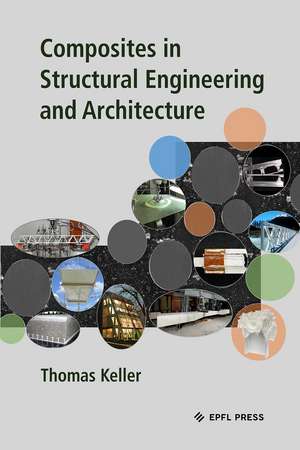Composites in Structural Engineering and Architecture
Autor Thomas Kelleren Limba Engleză Hardback – apr 2025
Composites in Structural Engineering and Architecture is about the author’s twenty-five-year journey as a pioneer, scientist, designer, and lecturer in the field of fiber-polymer composites as applied to structural engineering and architecture. Composites are construction materials that offer unique properties when compared to conventional materials such as reinforced concrete or steel. In addition to their excellent mechanical properties, their physical properties— including low thermal conductivity, transparency, and color—allow structural building physics and architectural functions to be integrated into individual features of buildings. This merging of functions in buildings, in addition to the modular and hybrid composite construction of bridges, gives rise to novel and compelling solutions regarding structural safety, serviceability, aesthetics, economy, and sustainability. Alongside these opportunities, however, composites may also reveal limitations in their structural application, which can be caused by their anisotropy or viscoelasticity, or in terms of ductility, fatigue, fire resistance, and durability. The monograph first addresses these limitations from a scientific point of view and then demonstrates how they can be overcome through suitable structural and architectural design. Subsequently, it is shown how the opportunities can be explored and the current design space expanded, to allow composites to develop to their full potential in structural engineering and architecture.
Preț: 371.78 lei
Nou
Puncte Express: 558
Preț estimativ în valută:
71.14€ • 74.28$ • 58.74£
71.14€ • 74.28$ • 58.74£
Carte nepublicată încă
Doresc să fiu notificat când acest titlu va fi disponibil:
Se trimite...
Preluare comenzi: 021 569.72.76
Specificații
ISBN-13: 9782889156474
ISBN-10: 2889156478
Pagini: 400
Ilustrații: 15 color plates
Dimensiuni: 190 x 240 mm
Greutate: 0.45 kg
Editura: EPFL Press
Colecția EPFL Press
ISBN-10: 2889156478
Pagini: 400
Ilustrații: 15 color plates
Dimensiuni: 190 x 240 mm
Greutate: 0.45 kg
Editura: EPFL Press
Colecția EPFL Press
Notă biografică
Thomas Keller is a pioneer, scientist, and designer in the field of composite bridge and building construction. As professor at the Swiss Federal Institute of Technology EPFL in Lausanne, he founded the Composite Construction Laboratory in 2000. As a practical engineer, he designed one of the first composite bridges in Europe and was responsible for the structural design of the five-story Eyecatcher Building.
Cuprins
"1. Composites – Compared
1.1 Terminology
1.2 Comparison across materials
1.3 Scope and content
1.4 References
2. Composites – Compact
2.1 Introduction
2.2 Materials
2.3 Components and members
2.4 Connections and joints
2.5 Manufacturing and installation
2.6 Composites in bridge construction
2.7 Composites in architecture
2.8 Composites in sculpture
2.9 References
3. Composites – Overcoming limitations
3.1 Introduction
3.2 Anisotropy
3.3 Imperfections and tolerances
3.4 Viscoelasticity
3.5 Curing and physical aging
3.6 Ductility
3.7 Fracture
3.8 Fatigue
3.9 Fire
3.10 Durability
3.11 Sustainability
3.12 References
4. Composites – Exploring opportunities
4.1 Introduction
4.2 Lessons learnt from nature
4.3 Structural form
4.4 Transparency
4.5 Function integration
4.6 Hybrid construction
4.7 Modular construction
4.8 References
5. Composites – How to design
5.1 Introduction
5.2 Conceptual design
5.3 Detailed fatigue and adhesive joint resistance verifications
5.4 Execution
5.5 Maintenance and rehabilitation
5.6 References
6. Composites – Where to go
6.1 Introduction
6.2 Lessons learnt and conclusions
6.3 Research needs
6.4 Education
6.5 References
Appendix"
1.1 Terminology
1.2 Comparison across materials
1.3 Scope and content
1.4 References
2. Composites – Compact
2.1 Introduction
2.2 Materials
2.3 Components and members
2.4 Connections and joints
2.5 Manufacturing and installation
2.6 Composites in bridge construction
2.7 Composites in architecture
2.8 Composites in sculpture
2.9 References
3. Composites – Overcoming limitations
3.1 Introduction
3.2 Anisotropy
3.3 Imperfections and tolerances
3.4 Viscoelasticity
3.5 Curing and physical aging
3.6 Ductility
3.7 Fracture
3.8 Fatigue
3.9 Fire
3.10 Durability
3.11 Sustainability
3.12 References
4. Composites – Exploring opportunities
4.1 Introduction
4.2 Lessons learnt from nature
4.3 Structural form
4.4 Transparency
4.5 Function integration
4.6 Hybrid construction
4.7 Modular construction
4.8 References
5. Composites – How to design
5.1 Introduction
5.2 Conceptual design
5.3 Detailed fatigue and adhesive joint resistance verifications
5.4 Execution
5.5 Maintenance and rehabilitation
5.6 References
6. Composites – Where to go
6.1 Introduction
6.2 Lessons learnt and conclusions
6.3 Research needs
6.4 Education
6.5 References
Appendix"
